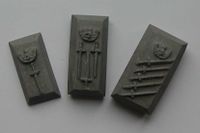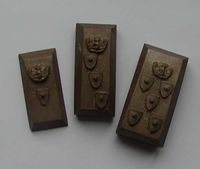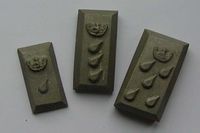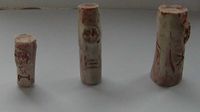Materials
Artisans use rare metals and natural materials to create magical items. Small amounts of these precious materials are produced by personal resources controlled by players and provided to them at the start of every Profound Decisions Empire event that they attend. If you choose a mine or a forest for your personal resource then you must choose one of the eight standard materials for your resource to produce.
Metals
A mine produces twelve units of one of these four metals. Mines can be diversified to produce small amounts of the other three metals.
Green Iron
This dark mineral is very soft, but has a high melting point. It is found in both iron and copper deposits. Improperly treated it creates a very brittle form of iron. Alloyed carefully with the correct proportions it produces a lightweight steel - even lighter than common mithril - that is supernaturally responsive to the needs of the wielder.
It is most commonly used in making weapons and heavy and medium armour. It is also used with copper to create jewellery, and the ore can be broken down to create glazes for ceramics and for glass, as well as a particularly fine green, blue and brown dyes.
Processed green iron ingots tend to be lighter in colouration than the raw ore, and are stamped with a sword symbol.
Orichalcum
This lustrous red mineral is most commonly mined at high altitudes, but exists throughout the Empire. It is tough, with a moderate melting point, and when polished looks a lot like gold. It is alloyed with iron to create orichalcum steel, or used in its pure form for inlays and other decorations. As with gold and silver, it can be used to create embroidery thread, although it is more commonly used in the form of jewellery pieces or buttons.
Orichalcum is valued for creating things that break or pierce, and for dissipating powerful blows. It is resistant to normal damage, and does not rust.
Ingots of orichalcum are stamped with the symbol of a shield.
Tempest Jade
This hard stone is prized for its translucency and beauty. It shares the same broad range of colouration found in other classes of jade but is especially translucent. Cloudy imperfections may form within the stone that cause it to change colour, or that shift in intensity over time; these 'tempest clouds' are part of what gives the material its name.
It is found in small deposits usually along with other hard stones. It is polished and carefully shaped and cut to provide decoration in a variety of crafts, especially in the form of jewellery.
Tempest Jade needs to be worked with care; mishandling the material causes it to splinter, sometimes violently. Artisans sometimes splinter tempest jade intentionally; the resulting splinters are further broken down to create a fine, abrasive dust that is used for polishing metal or finishing wood or leather. Materials finished with tempest jade end up with infinitesimal pieces of the stone embedded in their fabric.
Chunks of tempest jade are scored with a lightning bolt symbol.
Weltsilver
This is a precious metal found in veins of reddish, glistening ore that look like bleeding wounds in the rock. Legend says it is the blood of giants or first people that fell on the ground during some titanic battle. It is commonly found near deposits of other precious metals. Once refined it appears similar to silver, but more lustrous, and a little heavier. It is quite malleable, and has the fascinating quality of both warming up quite slowly and cooling down very quickly.
Weltsilver is very effective at shaping, directing and channelling living energies, but it is also quite resilient and flexible. By itself it is easily damaged, and is commonly alloyed with other materials. Alloyed with iron it creates particularly pale, reflective steel. It is most commonly mixed with gold or copper to create valuable, lightweight metals that are highly decorative. It is also suitable for making thread employed in "gold work" for embroidering banners, cloth and some lightweight armours.
Ingots of weltsilver are stamped with a blood-droplet symbol.
Natural Materials
A forest produces twelve units of one of these four natural materials. Forests can be diversified to produce small amounts of the other three materials.
Ambergelt
Ambergelt or living amber is a soft, resinous material that is carefully extracted from a living tree. Like amber it is found in various colours, and often contains preserved insects as inclusions. It is almost liquid when first extracted, but sets to become a tough, smooth material within a few minutes. It is used most often as decoration, but it can also be dissolved in strong alcohol to create a resinous varnish that adds a deep lustre to wood and leather.
Ambergelt can be carefully shaped and moulded. It is used when crafting items that slow, surround or encase living creatures. It is also sometimes called 'worldblood', and has some healing and preservational properties.
Measures of ambergelt are stamped with a wasp symbol.
Beggar's Lye
Ashes created by burning the dried wood of the rare beggarwood tree have a number of exotic alchemical properties that make them much in demand among crafters. Mixed with water, it creates a powerful lye solution that removes impurities and helps to tan hides, bleach cloths and quench metals. Mixed with pine resin, it produces a flammable material that can be used to heat forges and furnaces to very high temperatures.
The resulting caustic material removes impurities from other materials; it can be employed to make soft things harder and hard things softer for a short period after immersion or quenching, allowing many materials to be shaped more easily. Cloth bleached with beggar's lye will take other pigments exceptionally well, for example, and leather hides tanned in a solution of beggar's lye are particularly durable.
The fumes from Beggar's Lye are poisonous, and unless precautions are taken will cause breathing difficulties and damage eyesight over time. Those who work extensively with the material often have bleached skin or scars from acidic burns.
Measures of beggar's lye are sealed in ceramic bottles stamped with a skull symbol.
Dragonbone
Sometimes called 'worldmarrow' this is a soft material that resembles petrified bone or wood. Deposits are found in soil, especially around living trees. It can be carefully shaped and crafted when exposed to heat, but melts rather than burns. It shares many properties of clay or ceramic. It is a truly magical material that is often characterised as being “alive” in some indefinable way, despite being quite clearly inanimate.
Treated correctly it can take on a variety of colours, most commonly ivory white, tan or golden-brown. Once it has been shaped and set, it is quite difficult to damage by mundane means. It is most valued as a material that enhances and modifies the process of creating bonds - it is used in many items that allow multiple individuals to bond to them (such as banners and coven stones) or in items that “split” a single bond (such as paired items).
It is also favoured by followers of the Imperial Faith as a material that resonates well with spiritual energies.
Measures of dragonbone are carefully stamped with a dragon-head symbol,
Iridescent Gloaming
Iridescent gloaming is a powerful dye produced as a by-product in the manufacture of Rainbow Silk, a strong thread that is valuable both for embroidered decorations and for making beautiful cloth. The thread is tough and hard to snap or sever, requiring steady application of pressure to cut making it highly prized.
The silk is spun from the cocoons of the iridescent butterfly, a gorgeous insect with rainbow coloured wings that is uniquely active both during the day and at night. By day, the iridescent butterfly appears pale and drab – wings are usually white, ivory or light pastel shades. By night however, the true beauty of the iridescent butterfly is revealed – the wings become bright and luminous, shifting colour in seemingly random patterns, creating gorgeous displays in Summer and early Autumn as they dance among the twilight groves where their caterpillars feed. The butterfly does not prosper in the climate of the Empire and requires careful attention. It breeds most successfully in the Principalities of Jarm, where it is said that these creatures swarm in such profusion that they can transform night to day.
Iridescent gloaming is produced from the remnants of the cocoons which are ground down to produce a thick waxy substance. Iridescent gloaming has an almost magical quality that allows it to take on different colours in the hands of a skilled artisan and is noted for its use in creating exquisite embroidery, or as a colour wash for leather. Its peculiar magical properties make it a common component in items that use magic or produce magical effects.
The iridescent butterfly is used as a symbol by many Dawnish weaver cabals, and a bottle of iridescent gloaming is usually stamped with a butterfly symbol.
Ilium
Sometimes called star metal, ilium is a rare mineral that falls from the sky. It has magical properties that mean it is very much in demand by ritualists, crafters and even some apothecaries. It is most valuable because it can greatly extend the duration of many rituals and it can be used to create artefacts.
Ilium is not produced by mines or forests. Rather, it is allocated via campaign resources.
Common Metals
Copper and iron are common throughout the Empire and frequently alloyed with other metals to make weapons and armour. Alloys of these metals like bronze, brass and steel are hard and tough; they make equally effective weapons and armour that commonly count as heavy armour in Empire.
In addition to copper and iron, Imperial smiths frequently use mithril. Alloys of mithril are exceptionally light and as hard and tough as copper or iron. Any phys-rep of armour which is made from aluminium or titanium is considered to be a mithril alloy in Empire.
All three materials are sufficiently common that any character can own a weapon or suit of armour made of a copper, iron or mithril alloy, provided they have the phys-rep.







